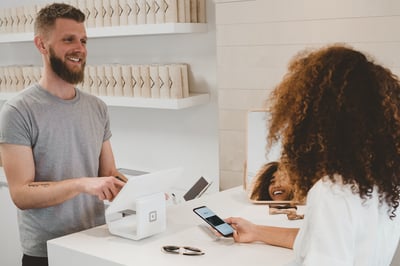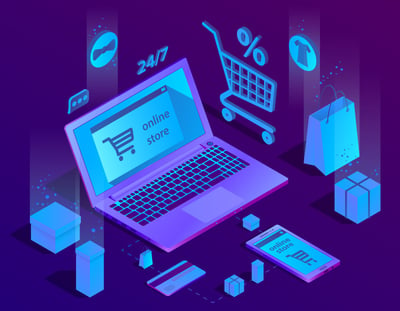December 13, 2024
 by Martina Ďurišinová / December 13, 2024
by Martina Ďurišinová / December 13, 2024

Have you ever received an email mentioning that one thing you’ve been seeking for weeks? You might have just stumbled upon a product recommendation email – a highly targeted and personalized message suggesting products to customers.
In this article, we will discuss the ins and outs of product recommendation emails, why you should implement them, and some useful examples and best practices to help you get started. Last but not least, we will briefly go over some well-known brands that swear by this tactic.
So, are you ready to make the most out of product recommendation emails and grow your sales?
Before we dive deeper, let’s define what product recommendation emails are.
In essence, product recommendation emails are personalized messages e-commerce businesses send to their customers. They suggest products based on customer data, such as previous purchases, browsing history, and on-site behavior. Ultimately, these emails are designed to create a tailored shopping experience for each customer with an aim to increase sales while building stronger relationships with your customer base.
Delivering personalized and relevant product suggestions straight to customers’ inboxes can significantly boost your sales. In fact, according to Barillance Research, product recommendations account for up to 31% of e-commerce site revenues. Let’s break down their other benefits.
Showing customers products that align with their interests improves engagement and entices them to further interact with your brand. Interestingly, a report on personalization by McKinsey shows that 78% of customers are more likely to make repeat purchases from brands that provide a personalized experience.
If a company sent you an email accurately anticipating your needs with a product, would you be inclined to buy it? Most people’s answer would be yes. While this makes it way easier for customers to shop, companies also reap the benefits.
Research shows that recommendations can lead to a 29% rise in company revenue, but when those recommendations are particularly relevant, they could enhance revenue by 30%.
Product recommendations go beyond selling items — they keep your brand top of mind for customers and enhance loyalty in e-commerce. Every personalized message shows that you are dedicated to improving customer experiences. Building this image over time makes your brand the place to go.
Customers want to feel heard and valued. Product recommendation emails allow you to create unique messages tailored to each customer, addressing their wants and needs.
Unsurprisingly, in a 2022 survey of online shoppers from various countries, 62% said they’d stop being loyal to a brand if it gave them a generic, one-size-fits-all experience. Personalized campaigns are a great tool for building an emotional connection and trust.
Paid ads and broad marketing campaigns can be a strain on your budget. In comparison, product recommendation emails offer a great return on investment (ROI). These messages reach customers who are already familiar with your brand, minimizing acquisition costs.
When it comes to reaching out to your customers with relevant product suggestions, the sky’s the limit. However, if you’re just starting out, the following sections will serve as an introduction to the most common and effective types of recommendation emails.
Welcome emails serve as an introduction to your brand, making a positive first impression. They are typically sent after a customer signs up. They often include product suggestions or a discount code to jumpstart the engagement, leading to increased first-purchase conversions.
Interestingly, welcome emails have an impressive average open rate of 50%. This makes them 86% more effective than regular newsletters.
Source: Vessi
Abandoned cart emails serve as a reminder, letting customers know about the items left in their cart and encouraging them to complete the purchase. You should send these within the first 24 hours of cart abandonment to make them extra effective. Including personalized suggestions and discounts further incentivizes customers to finish their shopping journeys.
Source: Food52
These emails suggest products based on a customer’s behavior, preferences, and past purchases. You can send them at any stage of the shopping journey, making them a versatile tool that keeps your brand visible across omnichannel e-commerce platforms.
Integrating product recommendations into an omnichannel strategy ensures that customers receive a seamless, consistent experience whether they’re shopping online, on mobile, or in-store, enhancing engagement and retention.
It’s a misconception that a customer’s journey ends when they buy a product. You should engage with your clients even after they receive their orders. Post-purchase emails can help you do just that. They check in with customers, often asking for reviews or suggesting complementary products. These messages show your brand’s attentiveness and can lead to repeat purchases.
Source: Casper
You can use upselling and cross-selling emails to offer complementary or higher-value items. These messages encourage customers to make additional purchases. The important thing is to suggest items that align with customers’ interests rather than promoting whichever products are popular at the moment. This way, you can maximize average order values while addressing customers’ needs.
Introducing new products or collections creates excitement and drives traffic to your website. You should send these emails to loyal customers first, making them feel valued.
Sending seasonal and holiday recommendation emails helps draw customers’ attention to your seasonal collections and gift guides. This makes it easiest for customers to shop during the peak season while driving sales.
Source: ASOS
These emails serve as reminders of loyalty rewards, such as points or exclusive offerings only for members. They help nurture existing customers, encourage repeated engagement, and build strong relationships.
Now that you’re familiar with the various ways you can use email to reach out to your customer base and recommend products, let’s discuss some of the best practices you should follow.
To effectively recommend products, you must know your customers. First, divide your audience into segments based on factors like age, interests, and purchase history. Then, thoroughly analyze a customer’s past purchases, browsing history, and behavioral data. You’re looking for patterns that will serve as a base for your recommendations.
Additionally, you should create customer personas, such as “the athlete” or “the luxury shopper.” Tailor your recommendations to fit each persona’s specific tastes.
Imagine you have a customer who loves the outdoors. They already bought a tent, sleeping bag, and camping stove. Based on this, you can recommend high-quality camping cookware and some nutritious camping-friendly meals to take their outdoorsy experience to the next level. This way, you can address their needs while driving sales.
Personalization is what sets you apart from your competitors. In the age where customer data is abundant, go beyond the standard first-name greeting. Here are three tips you should consider:
When it comes to product recommendation emails, less is usually more. You don’t want your customers to feel like they’re flipping through an entire catalog of random items.
A good practice is to display a few relevant products, usually 3-5. For example, if a customer recently purchased skincare products, you can recommend a cleanser, toner, and moisturizer.
It's also important to use clear and concise phrases that immediately communicate the advantages of the products you're recommending. Instead of saying “Best Seller,” try “Loved by 1,000+ customers.”
Source: Perigold
Did you know that content that includes images gets 94% more views? Images are the first thing customers see when they open an email. Therefore, you should invest in high-quality professional images that show your products in the best light. And that is often meant literally.
Lifestyle images are especially effective, as they showcase the items in everyday scenarios, allowing customers to picture themselves using them. Moreover, it’s important to highlight key parts of the email. You can draw a customer’s attention to specific products using design elements, such as badges.
Another useful practice is to stick to a cohesive color scheme for your emails and overall imagery. Ensure the colors, fonts, and styling fit your brand’s look. This helps make your brand more recognizable.
Source: Patagonia
Social proof is the king when it comes to building customer trust. Including reviews, ratings, and testimonials makes a world of difference in how customers perceive your products. To include social proof in your product recommendation emails, consider showing a snippet of a customer review beneath each product. For example, including “Rated 4.8/5 by 200+ customers” adds credibility.
You can also leverage user-generated content (UGC), such as images and quotes. Another option is to include influencer or celebrity endorsements. If a known and trusted figure endorsed your product, let your customers know. This can significantly boost their trust in your brand and help drive sales.
Including a CTA is crucial, as it directs customers to the next step in their shopping journey. Here are a few actionable tips to make your CTAs stand out.
Sometimes, customers need a little nudge. Offering incentives can prompt an action even if a customer wasn’t planning to buy anything in the first place. You can offer discount codes, like “Get 10% off these recommendations,” or incentivize larger purchases, for example, “Buy 2, Get 1 Free.”
Additionally, you should inform customers about the limited availability of certain items. Add “Only X left” or “In high demand” next to the product image to create a fear of missing out (FOMO) and prompt quicker purchasing decisions.
Source: Lands' End
Today, most online consumers are mobile. They will prefer a brand that offers seamless mobile experiences over a company with only an email marketing channel.
The first step toward creating positive mobile experiences is using a responsive design template. Luckily, most email platforms offer templates that adapt to any screen size. Before launching your email campaign, test on both desktop and mobile to ensure compatibility.
You should also ensure the images are lightweight so they can load quickly on mobile. Consider using the WebP format, as it can be anywhere between 25% and 34% smaller than JPGs.
Last but not least, avoid large blocks of text. Although longer paragraphs are manageable on desktops, they can quickly overwhelm mobile users.
Testing and refining your strategies is the best way to keep your emails fresh and aligned with your customer’s preferences.
Firstly, you should use A/B testing for important elements, such as subject lines, CTAs, and product placements. This will show you which version customers prefer.
Next, you should regularly monitor metrics like open, click-through, and conversion rates to see what resonates most with your audience.
Lastly, always prioritize customer feedback. Listening to your audience’s preferences allows you to stay in the loop and deliver recommendation emails that align with their preferences and shopping patterns.
Let’s look at four well-known brands that have mastered the art of recommendation emails.
Spotify uses recommendation emails to keep listeners engaged. They analyze users’ listening habits and send personalized recommendation emails, such as “Release Radar.”
Source: Spotify
Amazon has refined recommendation emails to a science. Based on customer data, the system can suggest everything from everyday essentials to unique finds.
Source: Amazon’s
Netflix’s recommendation emails focus on keeping subscribers engaged by suggesting content based on their preferences.
Source: Netflix
Adidas recommendation emails include “Complete Your Look” suggestions based on past purchases. It also highlights new arrivals or seasonal items.
Source: Addidas
Product recommendation emails are a great way to check in with your customer base, address their needs, and improve your sales figures. Throughout this article, we have covered everything you need to know to get started – from explaining these emails to implementing best practices to make them as effective as possible.
Remember, personalization is everything. You must know your audience to make each email feel tailored and unique. Adding strong visuals and social proof further enhances engagement and helps build customer trust. Additionally, with a mobile-friendly design and clear messaging, your emails are more likely to resonate with customers and lead to conversions. Continuously test and refine your approach to come up with the most effective strategies.
By following our best practices, you can skyrocket engagement, boost sales, and foster long-lasting customer relationships. Don’t wait – it’s time to turn every email into an opportunity for growth.
Discover why personalized marketing is the key to customer loyalty!
Edited by Jigmee Bhutia
Martina is a content writer with a background in tech and creative writing. At Luigi’s Box, she crafts engaging content ranging from blog posts to articles rich in data. Outside of work, Martina enjoys nature, reading, art, and embracing her love for geek culture.
In today's consumer-driven market, the modern customer demands personalized experiences that...
 by Pulkit Jain
by Pulkit Jain
Both dating and shopping make us want to feel special.
 by Inga Leder
by Inga Leder
For experience-based businesses, ticket sales are the fuel that keeps the engine running....
 by Megan Harr
by Megan Harr
In today's consumer-driven market, the modern customer demands personalized experiences that...
 by Pulkit Jain
by Pulkit Jain
Both dating and shopping make us want to feel special.
 by Inga Leder
by Inga Leder


